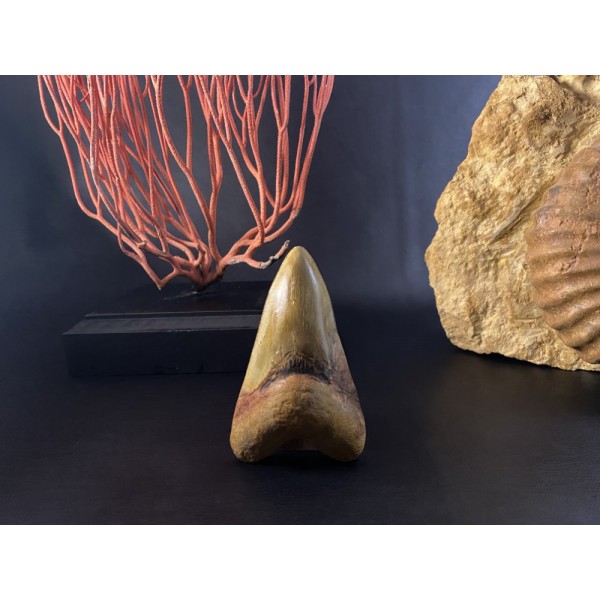Petrified wood trunk
Araucaria trunk piece from the famous Ambilobe Petrified forest in Madagascar.
These are formations from the Triassic period with around 220 million years.
Mounted in an acrylic base is a beautiful historic piece!
| close |
This shop uses cookies to improve your experience on our website. |
Reference: N99
Carcharocles megalodon - Neogen - Miocene, Burdigalian (15.97 - 20.44 million years) - Indonesia.
A large and superb tooth, with a wonderful colouration, as characterise the megalodon of Indonesia.
Dimensions: 6 cm x 10 cm
Weight: 105 g

Carcharocles megalodon - Neogen - Miocene, Burdigalian (15.97 - 20.44 million years) - Indonesia.
A large and superb tooth, with a wonderful colouration, as characterise the megalodon of Indonesia.
Araucaria trunk piece from the famous Ambilobe Petrified forest in Madagascar.
These are formations from the Triassic period with around 220 million years.
Mounted in an acrylic base is a beautiful historic piece!
Side table with petrified wood and three double handmade brass legs.
Top of the table is a slice of petrified tree - Araucaria species with 220 million years from Early Triassic period, with beautiful pattern and very dark color.
It comes from the Tsingy de Bemaraha National Park in Madagascar.
One of a kind piece.
Fossil sea urchin - Gymnocidaris koechlini - Excellent fossil of a sea urchin in life position.
The sea urchin and the spines finest details have been preserved and have been carefully arranged in position of life. The spines preserves the original colouring patterns. Sea urchin with 10 cm spicules - from medium Jurassic, Bajociano (168.3-170.3 million years), Boulemane, Morocco.
Beautiful Lamna Aschersoni shark teeth, Cretaceous (145 – 66 million years).
Pristine tooth, big size.
From Oued Zem - Morocco.
Carcharocles megalodon - Neogen - Miocene, Burdigalian (15.97 - 20.44 million years) - Indonesia. A huge, extra large and superb tooth, with a wonderful colouration, as characterise the megalodon of Indonesia. Beautiful teeth with a colour very similar to those of Chile and Peru, deposits closed for a long time. These megalodons have been on the market very recently.
Sperm whale fossil teeth from the Miocene period ( 23 to 5 million years ) of USA.
Beautiful rare decor piece, mounted in a black lacquered wood base.
Metacanthina barrandei from the Middle Devonian period (395 million years) of the Djebel Issoumour area, Atlas Mountains - Morocco.
Mounted in a black lacquered wood base.
Carcharocles megalodon - Neogen - Miocene, Burdigalian (15.97 - 20.44 million years) - Indonesia. A huge, extra large and superb tooth, with a wonderful colouration, as characterise the megalodon of Indonesia. Beautiful teeth with a colour very similar to those of Chile and Peru, deposits closed for a long time. These megalodons have been on the market very recently.
Nicaisolopha nicaisei from Upper Cretaceous of Cajamarca Peru, mounted in a white lacquered wood base.
Balanocidaris glandifera - fossil sea urchin - Carapace with radiolas, in a acrilic base.
Excellent fossil of a sea urchin in life position. The hedgehog and spines have preserved the finest details and have been carefully arranged in a living position. The radiolas preserve the original colouring patterns. It is a fossil worthy of a museum.
Sea urchin with spines up to 11 cm, from Upper Jurassic, Kimmeridgian (152.1-157.3 million years) - France.
Pleuroceras solare - Pyritised Lower Jurassic Ammonite from Germany, mounted in a black lacquered wood base.
A pyritised ammonite, which has been brass brushed to enhance the golden colour.
Hawskerense Subzone, Spinatum Zone, Middle Lias, Lower Jurassic, Butterheim, Germany Age:- 190 Million Years Old Ammonite.
Pleuroceras solare - Pyritised Lower Jurassic Ammonite from Germany, mounted in an iron base.
A pyritised ammonite, which has been brass brushed to enhance the golden colour.
Hawskerense Subzone, Spinatum Zone, Middle Lias, Lower Jurassic, Butterheim, Germany Age:- 190 Million Years Old Ammonite.
Perisphinctes sp. Ammonite from late Jurassic Period (160 million years), mounted in a exotic Tacula wood base.
Beautiful natural composition, from Sakahara fields in Southwestern Madagascar.
An exceptional Museum Quality slab with five Gigantopecten restitutensis fossil from Vaucluse quarry in S.E. France.
Lower Miocene (Burdigalien), around 20 to 16 million years.
It is very well prepared and clean, a "one of a kind" piece!
Jimbacrinus Bostocki (Crinoid Fossil - Ordovician 488 million years)
This is a rare piece, mass mortality plate of Jimbacrinus bostocki crinoid fossils from Western Australia with over 8 individuals on it.
These crinoids are 3D and have a very alien appearance.
The plate is 32cm x 20cm and has been nicely prepared.
These Jimbacrinus crinoids are hard to acquire due to Australia's strict fossil export laws.
This specimen was exported legally during the 80's and was part of a collection for years before being recently re-prepared.
Carcharodon Megalodon (Megalodon meaning “Big Tooth”) is an extinct species of shark regarded as one of the largest and most powerful predators in vertebrate history.
This beast lived approximately 23 to 3.6 million years ago, during the Cenozoic Era. Fossil remains suggest that this giant shark reached a length of 18 metres (59 ft), from USA.
Displayed in a glass box made to measure.